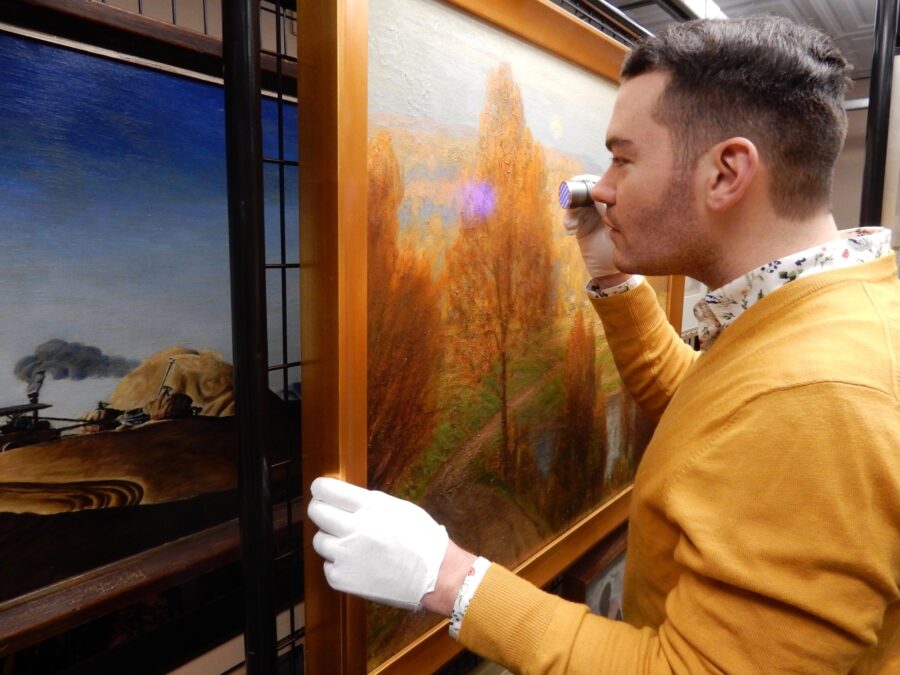Even as global economies brace for potential recession, high-profile artwork sales continue to make headlines, presenting an apparent paradox. Is this a sign of art’s unique resilience, or a market detached from reality? In an era of heightened economic uncertainty, geopolitical instability, and inflationary pressures, understanding how art performs as an investment and a store of value is more critical than ever for collectors, institutions, and the cultural economy at large. The art world witnessed a stark example of this complex dance with financial crises when Damien Hirst’s audacious £111 million auction at Sotheby’s proceeded on the very day Lehman Brothers collapsed in September 2008, setting a dramatic precedent for art’s often counter-intuitive behavior during economic turmoil. This juxtaposition of robust art sales against a backdrop of economic gloom hints at the multifaceted nature of the art market, where motivations ranging from pure passion to strategic financial planning converge. It compels an exploration into whether art universally acts to protect value or if its performance is, in fact, more selective and nuanced.
The Canvas of Crisis: Art’s Journey Through Past Recessions
The transition of artwork from purely aesthetic or cultural objects to recognized, albeit alternative, investment assets has been a gradual evolution, particularly pronounced in the 20th and 21st centuries. Economic downturns have often served as catalysts or critical testing grounds for this shifting perception, revealing both vulnerabilities and surprising strengths within the art market.
During the Great Depression of the 1930s, general art sales plummeted, and the number of lots sold at auction houses like Sotheby’s drastically reduced. However, this period also saw the rise of government patronage, notably the Works Progress Administration (WPA) in the United States, which provided employment for artists and fostered a shift in artistic themes towards Social Realism, making art more publicly accessible and reflective of societal struggles. Philanthropic efforts also played a crucial role, with significant cultural institutions such as the Seattle Art Museum being founded amidst the economic despair. This era demonstrated art’s resilience through alternative support structures and its capacity for thematic evolution in response to profound societal crises. The shift in patronage, from private collectors whose funds often diminished during a recession to governmental bodies, directly influenced the type of art produced, underscoring the socio-political impact on artistic creation during hardship.
The stagflation of the 1970s, characterized by high inflation and stagnant economic growth, prompted investors to turn towards tangible assets, including art, as a hedge against inflation. This period marked a significant step in the financialization of art, with the emergence of art investment funds and contemporary artwork gaining more serious recognition as an asset class. It highlighted art’s potential function to protect value against specific adverse economic conditions.
The early 1990s witnessed an art market crash following the speculative boom of the late 1980s, with art prices shrinking by as much as 55% between 1990 and 1993, according to Artprice data, and numerous galleries closing. In the aftermath, artists began experimenting more with non-traditional media such as photography, video installations, and performance art. Moreover, artists who had been formerly marginalized, including queer artists and artists of color, gained prominence as the traditional neutrality of “high art” gave way to more activist and socially aware artistic expressions. The recovery from this recession was slow, not materializing until the late 1990s, illustrating the market’s vulnerability to speculative bubbles and how such downturns can paradoxically foster artistic innovation and a reevaluation of dominant narratives.
The 2008 Global Financial Crisis initially triggered a sharp decline in art sales volumes and prices, with major auction houses like Sotheby’s and Christie’s reporting significant drops. Global art sales fell dramatically from $62 billion in 2008 to $30.5 billion in 2009. However, the market demonstrated a surprisingly rapid rebound by 2010, partly fueled by demand from emerging economies, particularly China, and the growth of online sales platforms. This period also saw an increased interest in art as a financial asset and a status symbol, while artists explored themes of capitalism and inequality. Despite the overall recovery, the prices for works by some prominent contemporary artists, such as Damien Hirst, Jeff Koons, Richard Prince, and Takashi Murakami, struggled to regain their pre-crisis levels for several years.
More recently, the 2020 COVID-19 Pandemic led to the closure of physical galleries and the cancellation or postponement of art fairs. This crisis spurred a rapid acceleration in digital adoption, with online viewing rooms, auctions, and sales becoming mainstream; online art sales notably doubled in 2020 to reach $12.4 billion. The period also saw the explosion of NFTs (non-fungible tokens) and artists exploring themes of isolation and connectivity. Even by 2024, art fair attendance by VIPs had nearly halved compared to 2019 levels, indicating a lasting shift in engagement patterns.
Each of these historical downturns reveals a pattern: economic crises often act as “filters” or “correctors” in the art market. Speculative excesses tend to be washed away, and the market often re-centers value on different artistic attributes, such as established historical importance, proven mastery (blue-chip art), or art that resonates deeply with the socio-economic climate of the time. This filtering process can reshape market hierarchies and artistic trends, sometimes pushing innovation or prompting a flight to what are perceived as “safer” bets. Furthermore, these crises have progressively integrated the art market more deeply into the global financial system, increasing its complexity and interconnectedness, meaning future downturns are likely to have more rapid and widespread effects, but also that recovery might be driven by a more diverse range of global actors.
Navigating Today’s Economic Crosscurrents: The Art Market Now
The global art market is currently navigating a period of significant recalibration, as evidenced by data from 2023 and 2024. This adjustment is not uniform across all segments, revealing shifts in collector behavior and regional dynamics. Global fine art auction sales experienced a notable contraction, falling by 27.3% in 2024 to $10.2 billion. This cooling is particularly evident at the highest end of the market, where sales of artwork priced above $10 million plummeted by a staggering 44.2% in 2024. This sharp decline suggests a pullback from speculative, top-tier investments, with the “trophy market” rapidly losing heat.
The ultra-contemporary segment, often fueled by speculative interest, also saw a significant downturn, with total auction sales dipping by 37.9%. The average price for a fine artwork sold at auction in 2024 was $26,293, a decrease of 26% from the previous year. However, amidst these contractions, the mid-tier market, comprising works priced between $100,000 and $1 million, proved more resilient. This stability suggests a continued engagement from collectors driven more by passion and a search for intrinsic value rather than purely speculative gains. This pattern indicates that the current market “correction” is not a wholesale collapse but rather reflects a flight towards perceived authenticity and lasting quality, potentially influenced by a more informed and value-conscious younger generation of collectors who prioritize cultural relevance.
Regionally, the United States remains the largest art market, with $4.3 billion in fine art auction sales in 2024, though this figure represents a 25.5% decrease year-over-year. Despite this drop, US sales are still approximately $1 billion above the pandemic-altered levels of 2020. China, the second-largest market, experienced a more dramatic dip of 46.1%, with sales totaling $1.9 billion in 2024, its lowest figure in a decade. This decline is attributed to a struggling domestic property sector and weakened consumer demand. The UK market contracted by 20.5% to $1.4 billion, its lowest total in a decade, affected by Brexit-related economic challenges and a reduction in the size of major auctions in London. France also saw a decline, with sales falling by 16% to just under $745.3 million, despite continued investment by auction houses in the region. In contrast, the Middle East, particularly Saudi Arabia and the UAE, is emerging as a new epicenter for the art world, driven by significant cultural investment initiatives like Saudi Vision 2030, which are attracting collectors and institutions. This geographic diversification could act as a stabilizing influence during economic downturns in traditional Western centers, though it also introduces new cultural and economic variables into the global value chain.
Key players are adapting their strategies. Auction houses like Sotheby’s, Christie’s, and Phillips, facing declining revenues from top lots, are likely recalibrating their focus, possibly towards private sales or the more resilient mid-tier. Notably, combined online-only sales at the major auction houses decreased by 10.8% in 2024 compared to 2023. Galleries are also adjusting, with some, like Pace Gallery which closed its Beijing location in 2019 due to economic challenges, potentially increasing their online presence and emphasizing long-term artist development over quick, speculative sales. Collectors, particularly High Net Worth (HNW) millennials and Gen Z, are exerting greater influence. This demographic is shifting towards more cautious and “meaningful” acquisitions, prioritizing cultural value, identity, and digital engagement.
Art fairs continue their post-pandemic recovery struggle. VIP attendance nearly halved between 2019 and 2024, and rising operational costs coupled with dampened collector spending have created what Michael Plummer, co-founder of Tefaf New York, termed a “very fragile fair ecosystem”. The proportion of dealers’ annual sales made at art fairs dropped from 46% in 2018 to 29% in 2023. This suggests a fundamental shift in how artwork is discovered and transacted, with significant implications for galleries reliant on the traditional fair model, forcing a rethink of their relevance and operational strategies.
Historically, the art market has demonstrated a degree of resilience compared to traditional financial markets. The Art Market Index, for instance, has often weathered economic cycles more effectively than the S&P 500. Following the 2007-2009 recession, the art market recovered approximately two years faster than the S&P 500, underscoring its potential as a distinct investment avenue.
The Art of Investment: Promise, Peril, and Protection
The notion of artwork as a “safe haven” asset, particularly during times of economic recession, is a subject of ongoing debate, presenting both compelling arguments and significant caveats. Proponents highlight art’s tangible nature, offering a sense of security that purely financial instruments may lack. Historically, certain segments of the art market, especially blue-chip artwork by established masters, have demonstrated a capacity to maintain or even increase their value over extended periods, sometimes outperforming inflation and offering a way to protect wealth. For example, blue-chip art reportedly outperformed the FTSE 100 by 200% between January 2000 and December 2023. Furthermore, art often exhibits a low correlation with traditional financial markets like stocks and bonds, providing valuable portfolio diversification benefits. This characteristic is increasingly recognized by wealth managers, with a Deloitte Art & Finance report indicating that 85% advocate for including art in balanced portfolios, and JP Morgan Private Bank clients allocating between 15% and 30% of their portfolios to alternatives, including art. During downturns, the focus often shifts to these high-quality, blue-chip works by established artists, perceived as safer investments.
However, the path of art investment is fraught with perils. One of the primary challenges is illiquidity; selling artwork can be a slow and arduous process, particularly when economic conditions tighten and potential buyers become scarce. High transaction costs, including auction house commissions, dealer fees, insurance, storage, and potential restoration expenses, can significantly erode returns. The art market is also known for its volatility and the subjective nature of valuation. Prices can fluctuate dramatically based on shifting trends, tastes, and an artist’s reputation, making consistent valuation difficult. Works by emerging artists are particularly susceptible to this volatility. Unlike stocks or bonds, art does not generate passive income like dividends. The risks of encountering fakes or forgeries are ever-present, making meticulous due diligence regarding authenticity and provenance crucial, yet often challenging. As tangible assets, artworks are also vulnerable to physical damage or destruction. Finally, tax implications, such as potentially high capital gains tax on collectibles (e.g., 28% in the US for long-term holdings), can impact the net profitability of an art investment.
The term “safe haven” in the context of art is therefore highly conditional and segment-specific. It largely applies to a very small fraction of the market, primarily blue-chip artwork, and necessitates considerable expertise, capital, and a long-term perspective. For the average investor seeking to protect their assets, the high costs and specialized knowledge required make art a less straightforward option compared to more traditional safe-haven assets.
Beyond financial considerations, the increasing financialization of art raises ethical and cultural dilemmas. A dominant focus on artwork as an investment vehicle can risk overshadowing its intrinsic cultural, aesthetic, and social value. Speculative bubbles, such as those seen in the late 1980s or more recently in segments of the ultra-contemporary market, can distort value, potentially harming artists’ long-term careers and misleading collectors. Moreover, the high prices often driven by investment demand can render art inaccessible to the broader public and smaller cultural institutions, reinforcing perceptions of elitism. The debate around art as an investment thus touches upon a fundamental tension in how society defines and measures value itself, is it purely economic utility, or does it encompass cultural, historical, and emotional significance that defies easy quantification but is crucial for long-term preservation and societal enrichment?
The Future Palette: Art and Economy in the Next Decade
Looking ahead, several emerging trends are poised to significantly shape the art market’s landscape and its performance during future economic cycles. Technological integration is deepening its roots within the art ecosystem. Digital platforms and online sales are expected to continue their growth and sophistication, further enhancing the global accessibility of artwork. Technologies like Virtual Reality (VR) and Augmented Reality (AR) are set to enrich viewing and purchasing experiences, allowing collectors to virtually place art in their own spaces before committing to a buy. Non-Fungible Tokens (NFTs) and digital art, having moved past their initial speculative frenzy, are likely to find more sustainable models for digital ownership and creation. Artificial Intelligence (AI) holds considerable potential, with applications emerging in art creation, authentication, valuation, and market trend analysis. Concurrently, the tokenization of high-value art is facilitating fractional ownership, which lowers barriers to investment and could increase market liquidity. This push for transparency via technology, such as blockchain for verifying provenance, could fundamentally alter how value is assigned and protected, potentially mitigating risks associated with authenticity and opaque dealings, though it may also challenge the roles of traditional gatekeepers like galleries and expert appraisers.
Evolving collector demographics will also play a crucial role. Millennials and Gen Z are steadily increasing their market influence. These younger collectors often prioritize artwork that reflects their personal values, social, environmental, as well as their identity and digital fluency. They are notably comfortable with digital art forms and online purchasing channels. This value-driven approach could lead to a more “impactful” art market, where an artwork’s capacity to drive social change or its ethical production becomes integral to its perceived value and resilience, particularly during crises that highlight pressing societal issues. There is also a growing demand for diversity and inclusion, with increasing interest in art from underrepresented artists and regions.
Sustainability and ethical practices are gaining traction, with a greater emphasis on eco-friendly materials, ethical sourcing, and transparent operations becoming central to the art world’s future. Globalization continues, with new market centers, particularly in Asia (following its current correction) and the Middle East, diversifying tastes and investment flows beyond traditional Western hubs.
Projecting art’s performance over the next 5–10 years, increased market segmentation seems likely. During recessions, the divergence between blue-chip or historically significant artwork (sought as a store of value) and more speculative contemporary or digital art may widen. Technology will remain a double-edged sword: while it enhances accessibility and transparency, it could also fuel new speculative bubbles or create novel avenues for fraud if not managed judiciously. The question remains whether it will truly democratize investment or further concentrate value. However, a more globalized market and a diverse collector base might offer some buffer against localized economic shocks, albeit increasing the complexity of predicting overall market behavior. As art investment becomes more accessible through fractional ownership and digital platforms, the market might see increased retail participation. While this could democratize access, it also carries the potential for increased volatility if less experienced investors react more erratically to economic news or market trends, potentially amplifying market swings during a recession rather than consistently protecting value.
Returning to the enigma of art’s performance during economic turbulence, it is clear that while the allure of artwork is timeless, its financial value is subject to a complex interplay of economic forces, human psychology, and shifting cultural priorities. The journey of art through past recessions is not a narrative of simple immunity, but rather one of adaptation, inherent resilience, and periodic redefinitions of value. This history underscores a consistent human need for both aesthetic engagement and alternative stores of value, particularly when uncertainty pervades traditional financial systems.
For those considering art as an investment to protect wealth, a nuanced understanding is paramount. It requires recognizing the stark differences between market segments, the relative stability of blue-chip artwork versus the volatility of emerging art, and acknowledging the inherent risks, from illiquidity to high transaction costs. Crucially, the value of artwork extends far beyond the purely monetary; it encompasses cultural, historical, and personal dimensions that are fundamental to its long-term endurance and appeal.
The art market’s landscape is perpetually reshaped by new technologies, evolving collector attitudes, and unforeseen global events. History provides a map of past responses, but the future will depend on the art world’s continued capacity for innovation and on how broadly its multiple forms of value are recognized and protected. Thus, the dialogue on art’s role as both a cultural touchstone and a financial instrument remains dynamic and open-ended, inviting ongoing critical engagement from all who participate in its world.









